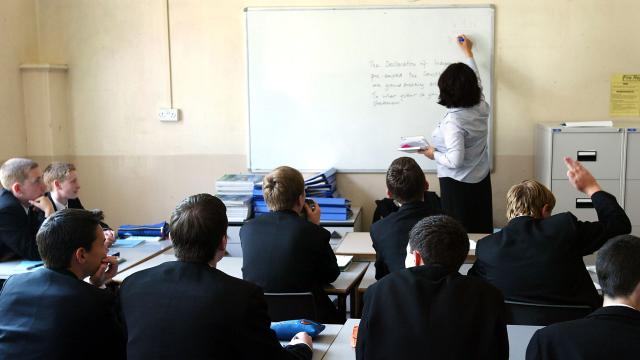A typical lesson in a Western classroom might look something like this: “What’s the most common gas in Earth’s atmosphere?” the teacher asks. Kids raise their hands.
Photo by Scott Barbour/Getty Images
“Oxygen?”
“Nope.”
“Carbon?”
“Nope.”
“Hydrogen?”
“Nope.”
“Nitrogen?”
“Yes!” And then the teacher will launch into a lecture on the properties of good ‘ol N2.
But in the race to get to the correct answer, the comfortable place our perfectionist brains know and love, where everyone’s heart rate can return to normal, we are skipping a critical opportunity for learning. Amy L. Eva at the Greater Good Science Center at the University of California, Berkeley makes a compelling case for focusing on errors, really studying them, to help students learn. It turns out that multiple studies suggest that the more confident you are in the wrong answer, the more likely you will remember the right answer after you’ve been corrected. Things stick better. And the whole learning process becomes process becomes productive, rewarding even, rather than ridden with anxiety about either “getting it” or “not getting it”.
And yet Westerners seem to have a pretty strong aversion to being wrong. A famous study by psychologists Harold Stevenson and James Stigler looked at the differences between Asian and American schoolchildren. Here’s how the findings were explained in the book Mistakes Were Made (But Not By Me), by Carol Tavris and Elliot Aronson:
By the fifth grade, the lowest-scoring Japanese classroom was outperforming the highest-scoring American classroom. To find out why, Stevenson and Stigler spent the next decade comparing elementary classrooms in the US, China, and Japan. Their epiphany occurred as they watched a Japanese boy struggle with the assignment of drawing cubes in three dimensions on the blackboard. The boy kept at it for forty-five minutes, making repeated mistakes, as Stevenson and Stigler became increasingly anxious and embarrassed for him. Yet the boy himself was utterly unselfconscious, and the American observers wondered why they felt worse than he did. “Our culture exacts a great cost psychologically for making a mistake,” Stigler recalled, “whereas in Japan, it doesn’t seem to be that way. In Japan, mistakes, error, confusion [are] all just a natural part of the learning process. (The boy eventually mastered the problem, to the cheers of his classmates.)”
It may have a lot to do with how teachers respond. Eva writes about the same study, pointing out that in their lessons, American teachers would primarily ignore errors and praise students for correct answers. (Perhaps this sounds like every class you’ve ever been in?) In Japan, though, the teachers would rarely praise kids at all – instead, they’d explore “a variety of pathways to both correct and incorrect solutions”. There’s no buzzer for the wrong answers, no confetti for the right ones. It’s all just part of the big, long, complex process of learning.
[referenced url=”https://www.lifehacker.com.au/2017/08/ask-kids-what-did-you-fail-at-today/” thumb=”https://i.kinja-img.com/gawker-media/image/upload/t_ku-large/xlvbp9p2vxqnpu7rgpqh.jpg” title=”Ask Kids ‘What Did You Fail At Today?’” excerpt=”At elite universities, faculty members have been noticing a problem. Many students, while impressive on paper, seem to be unable to cope with simple struggles – getting assigned to a dorm room they’re not thrilled with, scoring less than an A-minus on a midterm, or not making the cut on school teams. The lack of resilience has become so apparent that Smith College now offers an entire course on how to fail. (One uncomfortable class project. Having your worst failures projected onto a large screen in the campus hub. Ouch.)”]
One way that parents and teachers can help kids think about the wrong answers is have them make guesses about the material before they actually learn it. Scientific American gives this great tip for studying textbooks: Before reading a chapter, try to answer the questions in the back of the book. (Or convert the section headings into questions – “If the heading is Pavlovian Conditioning, ask yourself What is Pavlovian conditioning?”) Yeah, you’ll probably be wrong, but the action sets your brain up to learn when you start reading the material. (For those who don’t have any tests to take, if you really want to learn something, try guessing the answer before you turn to Google.)
As a parent, it’s also important to model healthy reactions to mistakes. When Eva’s daughter was a toddler, she would regularly spill milk in front of her during meal time, and say, “Oops, oh well, no big deal, let’s clean it up!” The earlier we teach kids that errors are a part of life, the more space they will have to discover directions leading to something awesome.

Comments